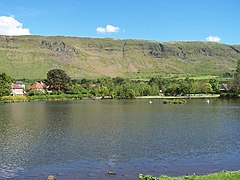Lennoxtown
Lennoxtown
|
|
|---|---|
 Lennoxtown Dam, with the Campsie Fells behind |
|
| Lennoxtown shown within East Dunbartonshire | |
| Population | 3,773 |
| OS grid reference | NS625775 |
| Council area | |
| Lieutenancy area | |
| Country | Scotland |
| Sovereign state | United Kingdom |
| Post town | GLASGOW |
| Postcode district | G65 G66 |
| Dialling code | 01360 |
| Police | Scottish |
| Fire | Scottish |
| Ambulance | Scottish |
| EU Parliament | Scotland |
| UK Parliament | |
| Scottish Parliament | |
Lennoxtown (Scottish Gaelic: Baile na Leamhnachd, pronounced [b̊alə nə ʎãũnəxɡ̊]) is a town in East Dunbartonshire, Scotland at the foot of the Campsie Fells, which are just to the north.
It is now part of the East Dunbartonshire council area but prior to 1975 was in the historic county of Stirlingshire.
It had a population of 3,773 at the 2001 UK census.
The focus of the Lennoxtown area used to be the busy Lennox Mill, where tenants of the Woodhead estate brought their corn to be ground. There were several corn mills in Campsie Parish, but this was arguably the most important. Lennox Mill was located in the vicinity of the recently demolished Kali Nail Works.
A significant event in the history of the locality was the establishment of the calico printing works at Lennoxmill during the late 1780s, on a site adjacent to the old corn mill. Calico is a type of cotton cloth, and the printing of cotton cloth was soon established as a major industry in the area, also at Milton of Campsie. It was to provide accommodation for the block makers and other cotton printing workers that the village of Lennoxtown was established, during the late eighteenth and early nineteenth centuries. Streets of houses were planned and built according to a formal plan. Lennoxtown was at first known as 'Newtown of Campsie', to distinguish it from the Sirktown' or Clachan' of Campsie, at the foot of Campsie Glen.
During the 19th century Lennoxtown grew to be the largest centre of population in Campsie Parish. Another important industry was soon established – a chemical works, founded by Charles Macintosh (of waterproof clothing fame) and his associates. At first their principal product was alum, a chemical employed in the textile industry. Alumschist, the basic ingredient in the process, was mined in the area. The works came to be known as the Secret Works, presumably because of the need to keep the industrial processes secret.
...
Wikipedia

